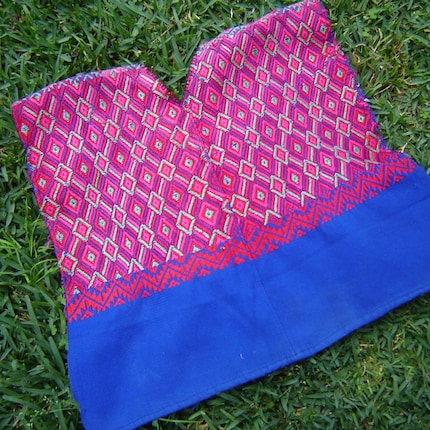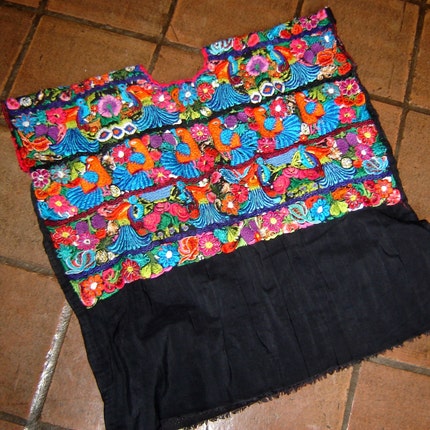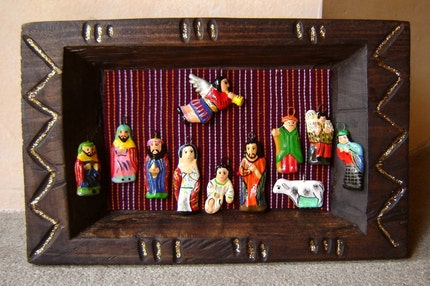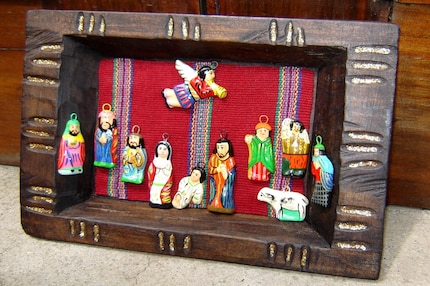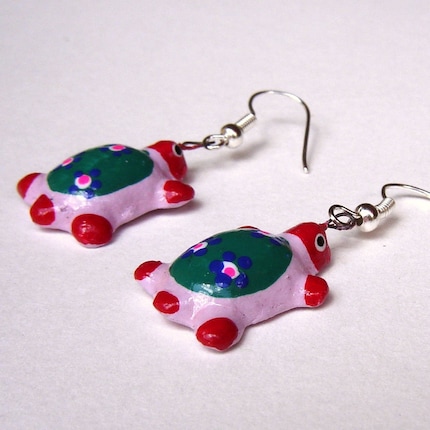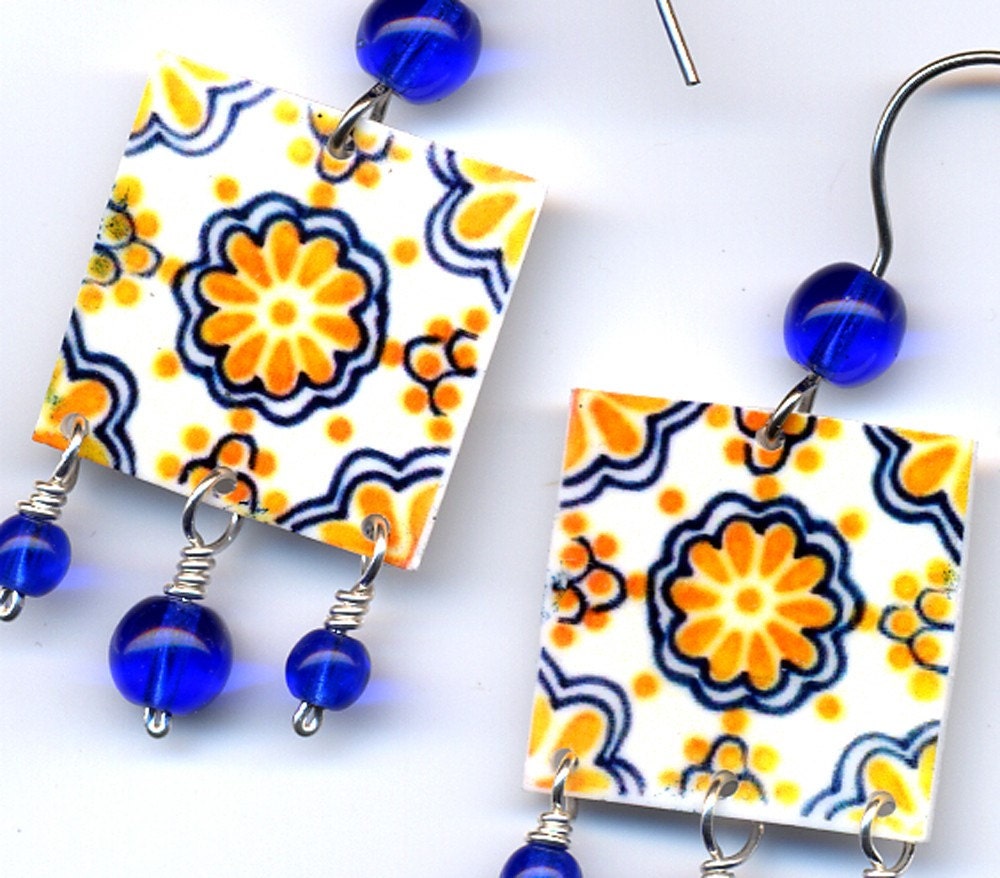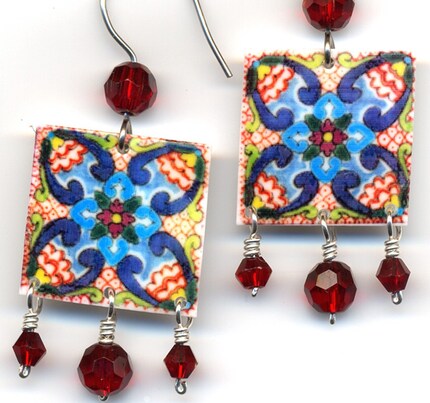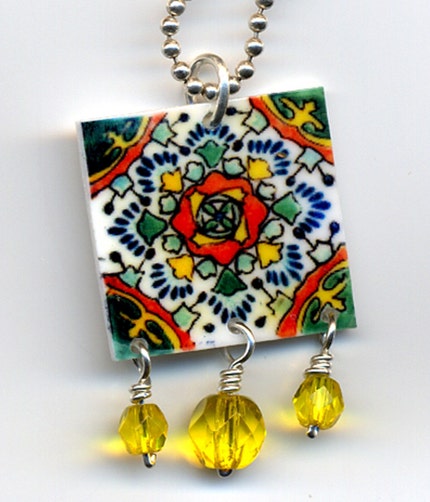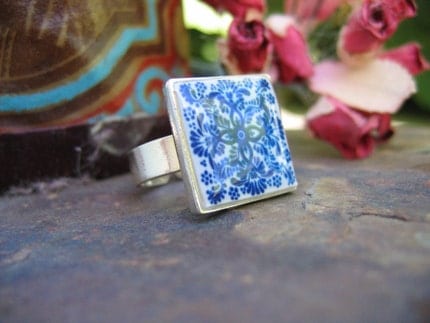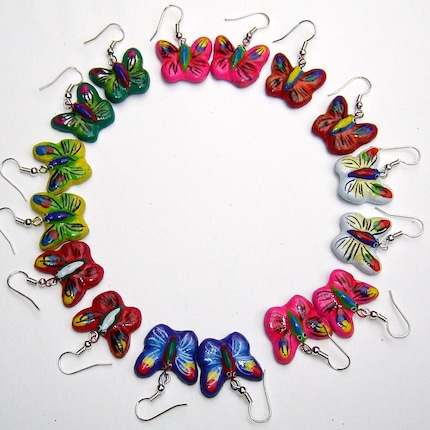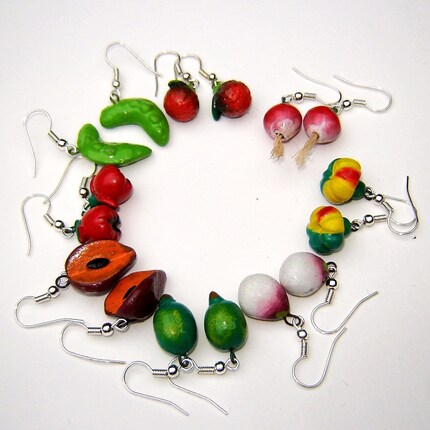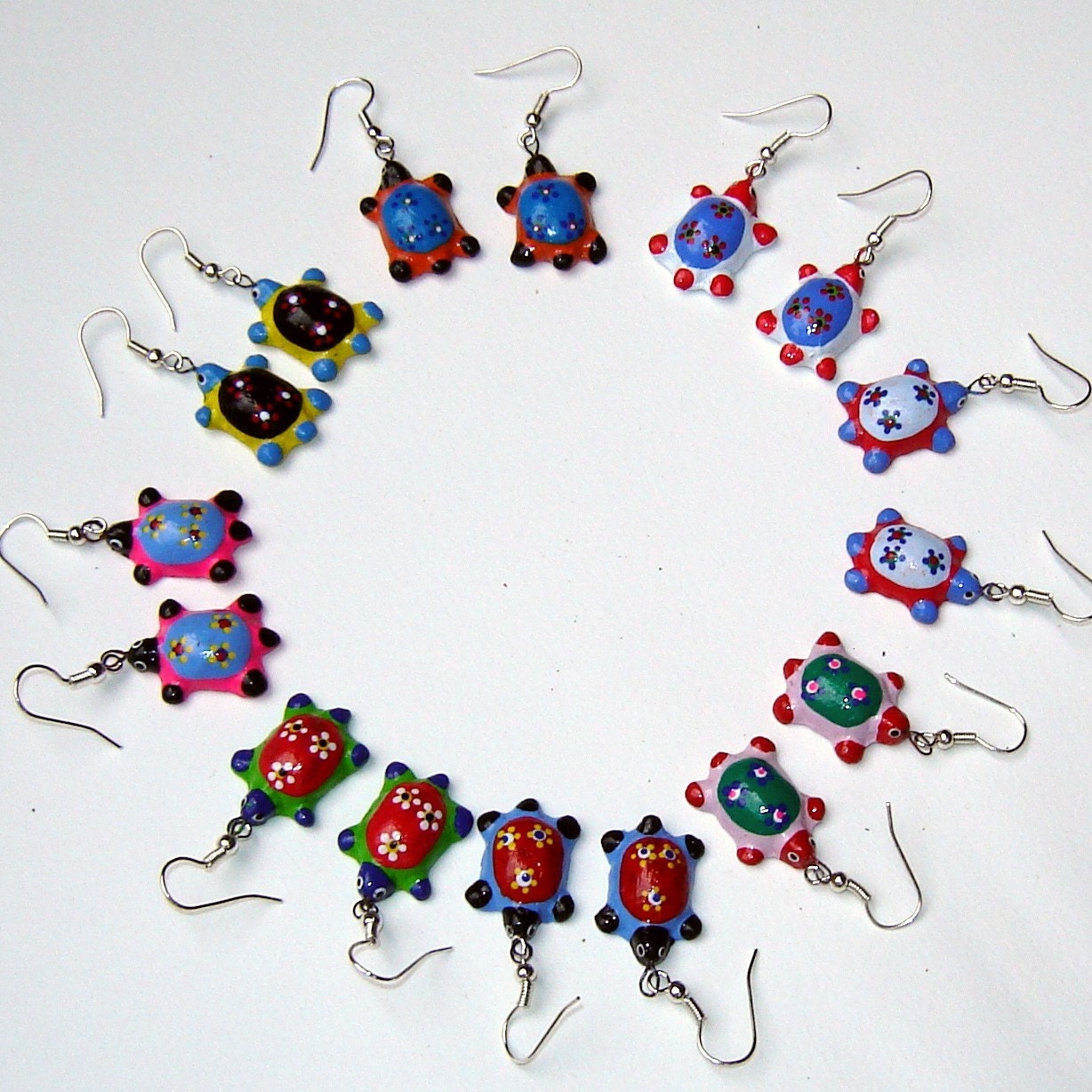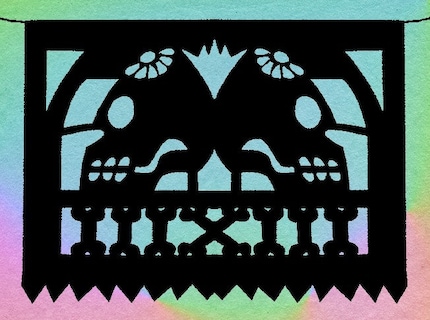Aguacatan is a village in the Guatemalan department of Huehuetenango. The huipiles there are made using white, satiny, commercial cloth and a variety of colorful commercial ribbons. The collars and other adornments are hand-embroidered. It's a very light and fresh look!
I don't have any huipiles from Aguatacan, but I want to get one before I leave Guatemala. I did seek out some of the ribbons used on them, and I found some yesterday in the mercado. I don't know what I'm going to make with them yet.
The first photo shows the ribbons I bought yesterday. Click on other the photos below to see more photos of each huipil.
Thursday, October 30, 2008
Wednesday, October 29, 2008
Santa Maria de Jesus
Santa Maria de Jesus is a village not far from Antigua, Guatemala, and it has two basic designs for huipiles. The hand-woven versions (like the one on the left) feature a diamond-shaped pattern, usually in hot pink, purple, red, and green. The machine-embroidered versions (like the one on the right) are on commercial cloth and feature brightly colored birds and flowers.
Sunday, October 26, 2008
Meet Jose, Ceramic Artist
A few weeks ago I visited the Antigua workshop of Jose, the man who makes many of the ceramic beads I sell. He is the 6th generation of ceramic artists on his mother's side! His mother made ceramics and his father was a carpenter. Jose has been in the ceramics business for 28 years and has four children, but none of them plan to continue in the family business; he says they have gone to college and begun different careers. He has two employees in his workshop, and there are several other people who have their own workshops upon whom he can call if a big order comes in. He also has an employee who works at the store where he sells his items.
Some of the ceramic items Jose makes are made using molds, others are completely hand-formed, and others are a combination. He showed me the process of making a little cherub: He started with the wet clay (purchased in the nearby city of Chimaltenango), pressed it into molds to make the wings and head, and hand-formed the body, arms, and legs. Small clay items dry in the sun for about an hour before being put in the kiln.
Jose has an electric kiln but usually uses the wood kiln because of high energy costs. After being fired, the pieces are painted with acrylics and most are then glazed.
Jose's workshop is at his home and was much larger 10 or 15 years ago, when he had 16 employees. Business, which is highly dependent on the tourist trade, has slowed in recent years. He does, however, have three customers in the US who purchase large quantities for their retail stores. He makes lovely, very detailed nativity scenes for export.
Jose says his most popular beads are miniature Guatemalan masks, devils, and monkeys. He does custom orders based off of photos or sketches, if a customer needs a large quantity of a particular design!
Some of the ceramic items Jose makes are made using molds, others are completely hand-formed, and others are a combination. He showed me the process of making a little cherub: He started with the wet clay (purchased in the nearby city of Chimaltenango), pressed it into molds to make the wings and head, and hand-formed the body, arms, and legs. Small clay items dry in the sun for about an hour before being put in the kiln.
Jose has an electric kiln but usually uses the wood kiln because of high energy costs. After being fired, the pieces are painted with acrylics and most are then glazed.
Jose's workshop is at his home and was much larger 10 or 15 years ago, when he had 16 employees. Business, which is highly dependent on the tourist trade, has slowed in recent years. He does, however, have three customers in the US who purchase large quantities for their retail stores. He makes lovely, very detailed nativity scenes for export.
Jose says his most popular beads are miniature Guatemalan masks, devils, and monkeys. He does custom orders based off of photos or sketches, if a customer needs a large quantity of a particular design!
Thursday, October 23, 2008
The Zen of Cutting Up Scraps
I enjoy putting together my scrap samplers because there's something relaxing about taking weirdly shaped pieces of fabric and cutting them into relatively-normally-shaped, small pieces for someone else to use. My mind is free to go wander as I cut and select 35-40 pieces for a bag. I think about the design of the huipiles or cortes from which each piece came, and where the fabric was made.
Yesterday I put together several scrap samplers; below is a photo of one of them. Again, for any of you who have purchased these in the past, I'd love to see the craft projects you've used them in!
Yesterday I put together several scrap samplers; below is a photo of one of them. Again, for any of you who have purchased these in the past, I'd love to see the craft projects you've used them in!
Tuesday, October 21, 2008
Name Piece in Frame
Reader D emailed me a photo of her son David's huipil name piece all framed and hanging on the wall. I like the colors she chose for the mat and frame!
Monday, October 20, 2008
Vicenta
We met a lovely woman named Vicenta at her home workshop on Saturday. She lives here in Antigua and makes worry dolls, sews fabric bags, and makes jewelry sometimes, too. I made a large purchase from her, including two sizes of bags and two sizes of worry dolls.
Here's a picture of Vicenta next to her handiwork, and a few of her in-process worry dolls!
Here's a picture of Vicenta next to her handiwork, and a few of her in-process worry dolls!
Friday, October 17, 2008
Great Use for a Huipil Collar
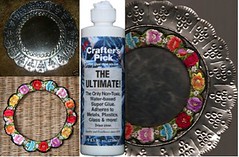
Kansas Kate purchased a huipil collar from me last month and had an interesting idea: She affixed it to to a tin frame made in Mexico. It turned out very nice! She also provides a suggestion for a good adhesive to use for craft projects like this.
If you've got any photos of items you've made from huipil fabric or trim, please let me know... I'd love to display your work!
Thursday, October 16, 2008
Earring Giveaway Winner!
The winner of the turtle earrings, chosen via random.org, is commenter lunadelmar!
Thanks to everyone for entering!
Thanks to everyone for entering!
Wednesday, October 15, 2008
Mural: Men in Guatemala
On the wall opposite the women's mural in Dona Luisa's is a mural dedicated to the men of Guatemala. It is a wonderful work of art that presents Guatemalan men in different roles. Just as the center of the women's mural was a weaver, the center of this mural is a man working on a farm. Weaving and cultivating the land are traditionally two of the most important activities in Guatemala.
Guatemalan history is portrayed in the mural's display of the Mayan temples and the Spanish conquistadors. One can also see present-day men building and participating in sciences and music. My favorite scenes in this mural relate to rituals and customs: Look for the giant kite for Day of the Dead in Santiago Sacatepequez, men swinging incense burners and carrying religious signs during a procession, the pole swingers in Chichicastenango, and more.
On the left-hand side a man's hands release a dove: a wish of peace for Guatemala.



Guatemalan history is portrayed in the mural's display of the Mayan temples and the Spanish conquistadors. One can also see present-day men building and participating in sciences and music. My favorite scenes in this mural relate to rituals and customs: Look for the giant kite for Day of the Dead in Santiago Sacatepequez, men swinging incense burners and carrying religious signs during a procession, the pole swingers in Chichicastenango, and more.
On the left-hand side a man's hands release a dove: a wish of peace for Guatemala.



Monday, October 13, 2008
Mural: Women in Guatemala
There are two large murals upstairs at a popular Antigua restaurant called Dona Luisa Xiconcatl: one dedicated to the women of Guatemala, and the other to the men. Today I wanted to showcase the mural of women.
Notice all the tasks and scenes associated with femininity in Guatemala, with the centerpiece being weaving with the backstrap loom. Others include making tortillas, buying and selling produce in the market, giving birth and assisting with birth, remembering the villages that were massacred during the civil war; dedicating children to the earth and to their God; participating in technology and sciences; cultivating plants and raising children; taking part in ceremonies; and holding hope for the future.
I like the woman at the top center, who's made up the parts of the landscape: forest, village, mountain, and river.
Notice all the tasks and scenes associated with femininity in Guatemala, with the centerpiece being weaving with the backstrap loom. Others include making tortillas, buying and selling produce in the market, giving birth and assisting with birth, remembering the villages that were massacred during the civil war; dedicating children to the earth and to their God; participating in technology and sciences; cultivating plants and raising children; taking part in ceremonies; and holding hope for the future.
I like the woman at the top center, who's made up the parts of the landscape: forest, village, mountain, and river.
Saturday, October 11, 2008
Nativities
I found a bowl full of nativity character beads at one of my favorite bead places in town. I spent a week or so deciding what to do with them before I came across hand-carved wooden trays that were a great stage for the scene. I added rectangles of used burgundy huipiles to add some more color, and gold glitter glue to accent the carvings on the front I've made two of these so far, and in addition to the ones I put in my Etsy shop, I'm going to give some as gifts (and keep one for myself! Heehee).
Wednesday, October 8, 2008
Turtle Earring Giveaway!
I put some cute Guatemalan turtle beads onto silver plated ear wires, and voila! Earrings for another blog giveaway. The earrings will come in a little Guatemalan fabric bag.
All you have to do to enter is leave a comment on this post (and don't forget to leave an email address or URL so I can reach you if you win!) by 11:59pm (Mountain time) next Wednesday, 10/15. Please let me know what your favorite item in my Etsy shop is!
Next Thursday I will announce the winner, and these earrings will be mailed to the winner (US address only) by the end of the 3rd week of October. Make sure you leave an email address or URL in your comment so I can contact you if you win!
If you like these earrings, I have many other cute novelty earrings and bracelets in this section of my Etsy shop :)
All you have to do to enter is leave a comment on this post (and don't forget to leave an email address or URL so I can reach you if you win!) by 11:59pm (Mountain time) next Wednesday, 10/15. Please let me know what your favorite item in my Etsy shop is!
Next Thursday I will announce the winner, and these earrings will be mailed to the winner (US address only) by the end of the 3rd week of October. Make sure you leave an email address or URL in your comment so I can contact you if you win!
If you like these earrings, I have many other cute novelty earrings and bracelets in this section of my Etsy shop :)
Monday, October 6, 2008
Mexican Tile Jewelry
I love the jewelry in Shrunken Cat Heads' shop - It's inspired by Mexican tiles, and she makes the tiny tiles herself. They're so colorful!
Cori Crooks is the woman behind Shrunken Cat Heads. She had this to say about her craft:
Cori Crooks is the woman behind Shrunken Cat Heads. She had this to say about her craft:
I take inspiration for my work from my childhood neighborhood. As native of the San Francisco Bay Area, I had the good fortune to grow up around many different cultures. My Mexican tile jewelry and world tiles are reflective of my childhood neighborhood brimming with color, be it the tiled Chicano mural on the side of the local tortilla factory, or the hand painted tiles which wrapped around the building of my community's Portuguese newspaper, or the classical roman shapes that tiled the Spanish mission down the road. These images stuck with me and are a direct influence on my design and use of color. I recreate these classical patterns and prints them on to miniature tiles, which then become the foundation of my wearable art.
Saturday, October 4, 2008
Fiesta Favors
Thursday, October 2, 2008
Peruvian Monkey
One of the local shops I go to carries some dolls and stuffed animals made in Peru. I couldn't resist this little monkey! He's made of wool and has hands that tie together so he can hang around. I'm going to give him to my little girl for Christmas.
Wednesday, October 1, 2008
Papel Picado by Aymujer!
Aymujer is a colorful Etsy shop run by two sisters, Yreina and Elsa. One of the products they offer is papel picado. The banners using this technique serve as a beautiful decoration for many occasions! Yreina was kind enough to write about papel picado for this blog.
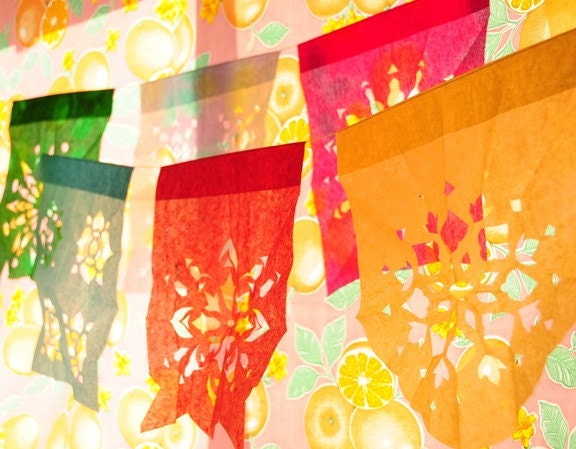
Papel picado literally translates to ‘punched paper’. It is also sometimes referred to as papel de China or ‘Chinese paper’. Chinese paperwork arrived on trading ships from the east— along with ivory, spices and porcelain. The very fine, thin paper that the porcelain was wrapped in surpassed the existing natural fiber paper papers of Mexico. The Spanish also contributed to Mexican papel picado, bringing their styles of paper-cut lace from Europe. These, along with the tissue-thin Chinese paper, were quickly absorbed into Mexican folk art.
Traditionally, Mexican artisans punch their designs with mallet and chisels through thick stacks of tissue paper. In this way, it is possible to produce many flags from a single template. Families have sustained themselves over generations by passing down their unique designs, methods and styles of making papel picado.
Today, papel picado can be found on home altars, at gravesites on el Dia de los Muertos, and virtually any celebrations such as baptisms, weddings and funerals. Modern designs have expanded to include: Easter, Halloween, Christmas, birthdays, Valentine’s Day, Independence Day and more.
What I make is, technically, papel cortado or ‘cut paper’. Depending on the design, I use scissors or an exacto knife. I draw out my original patterns and create a template. I can’t cut through as many flags at once like the chisel method, but I prefer the more intricate and delicate patterns that the exacto blade produces.
I’ve been making papel for a while now. I only recently started taking pictures of my flags. I don’t know why--- I guess that when you take something for granted, it doesn’t seem possible to sell it. My sister-in-law and I conceived our Etsy store in June of this year. Originally, I listed my papel because it made our shop look pretty! It really surprised me when it became our best-selling item. I have pushed myself to become at least a part-time capitalist, so I make sure to shoot pictures of the flags as I make them and list frequently. I enjoy building our little shop. Hopefully, it will keep on growing.
Subscribe to:
Posts (Atom)





